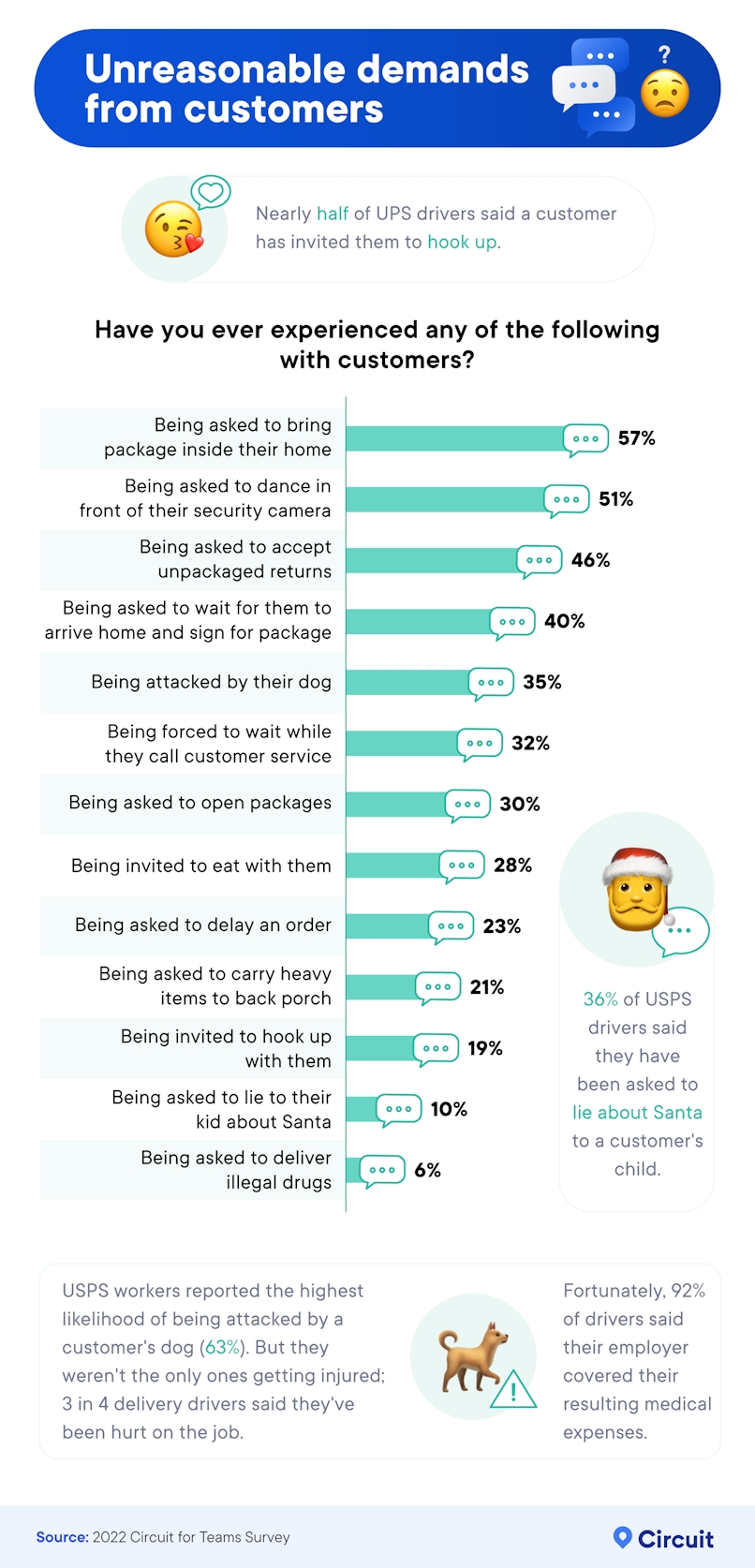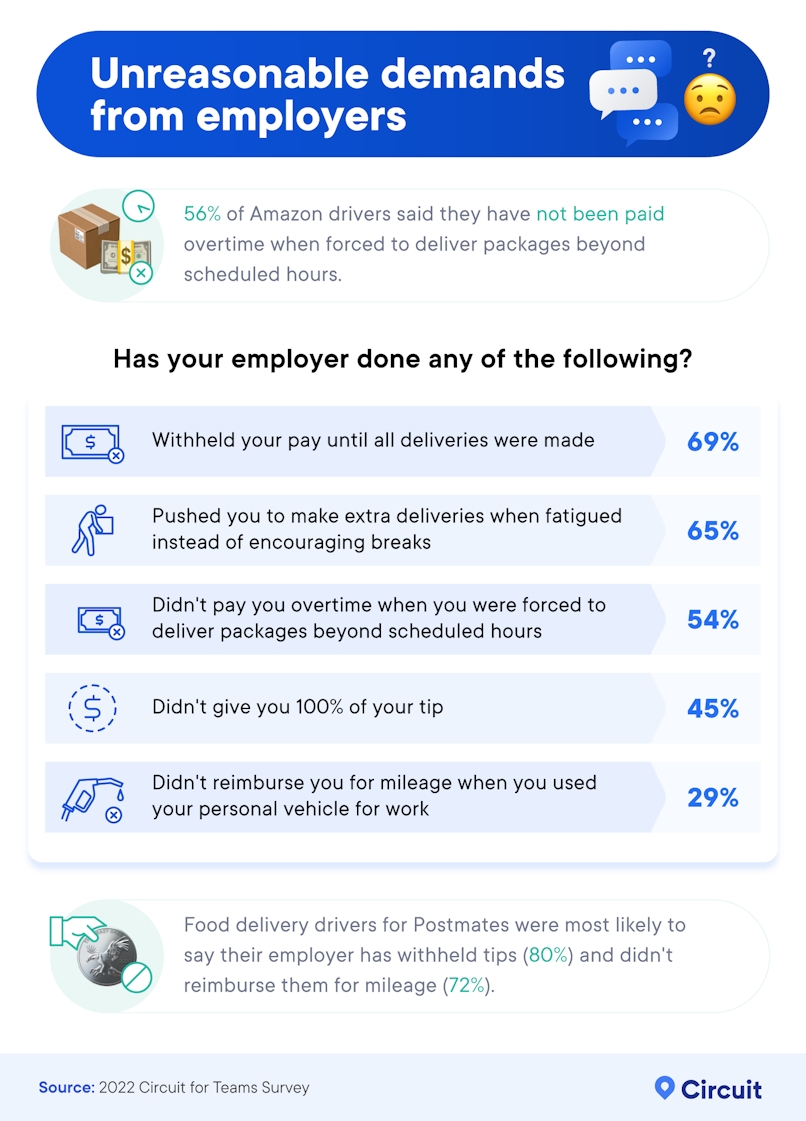Delivery Driver Burnout from Unreasonable Demands
Delivery drivers endure unreasonable demands from employers and extreme customer requests. How can managers help drivers avoid burnout?

We investigated the on-the-job experiences of 1,002 delivery drivers to explore unrealistic delivery quotas to inappropriate customer requests.
Key takeaways
- 83% of delivery drivers have experienced burnout and worry they’ll be fired if they fail to make all their deliveries on time.
- Only 2% of delivery drivers said they felt no pressure to make deliveries on time. Drivers from the following delivery services were the most likely to have experienced burnout: USPS, UPS, and GrubHub.
- 3 in 4 delivery drivers have been injured on the job.
- Nearly half of UPS drivers have been invited by a customer to hookup.

The increasing demands of delivery driving
Delivery drivers have many demands placed on them by employers and customers: delivery quotas, meticulous record keeping, heavy package handling, and special delivery requests are just a few.
(Sometimes, these demands cross the line into outrageous or even illegal).
What types of unreasonable demands do companies make of their delivery drivers? How extreme can customer requests get?
We surveyed 1,002 delivery drivers about their company expectations and customer experiences.
How irrational are delivery demands, and what can dispatch and team managers do to help their drivers feel safer and less stressed? Let’s find out.
How delivery drivers are feeling the pressure
Delivery drivers are in higher demand than ever, which has led to increased pressure on driver performance. With employer expectations bordering on impossible, many drivers are experiencing burnout.

Delivery drivers are definitely feeling the pressure, as 83% of drivers we surveyed said they experienced burnout.
Demanding delivery schedules was the number one cause of burnout: 98% of drivers felt pressure to make their deliveries on time, and 83% feared their boss would fire them if they didn’t.
Drivers who failed to make deliveries on time were given the worst routes (61%), denied tips (52%), suffered verbal abuse from customers (36%) or managers (30%), and had pay withheld (19%), among other punishments.
The pressure on drivers increased with the installation of cameras in vehicles; 86% percent of delivery drivers said their employers record them when driving a company vehicle.
For UPS and FedEx drivers, that number jumped to 94% and 92%, respectively.
These demands led 79% of delivery drivers to work extra hours and drive while drowsy. With the holiday season revving up, driver stress will only increase — as will safety concerns.
Dispatcher Advice: The best way to help your drivers avoid burnout is to plan and assign routes carefully. Keep driver deliveries localized, optimize routes to avoid backtracking, prioritize time-sensitive deliveries for easy management, and make packages easy to find in crowded vehicles.
Logical and orderly delivery routes maximize driver time, which can reduce stress. Also, maintain communication with your drivers while they’re on the road, so they can easily report traffic, accidents, or customer issues.
Key takeaway: 83% of drivers experienced burnout and feared being fired if deliveries weren’t on time.
Customer demands and illegal employer practices add to the difficulty of delivery
As if the demand for on-time delivery wasn’t enough, drivers also have to face customer and manager demands.
From the seemingly innocent to the downright illegal, these demands add even more stress, anxiety, and fear.

Delivery drivers are frequently asked to perform tasks outside their job description.
57% were asked to carry a package inside a customer’s house, 46% were asked to take an unpackaged return (59% of UPS drivers), 40% were asked to wait for a customer to get home, and 32% were asked to wait while a customer called customer service.
While those may seem like simple requests, company demands for on-time delivery mean every second counts for delivery drivers. They don’t have time to carry packages inside or wait for customers to get home.
However, when drivers deny these requests, sometimes customers complain, and managers get upset. So drivers have to choose: hit their quotas and deadlines or satisfy the customer.
But customer demands go far beyond a few extra steps or a couple of minutes of waiting.
Customers have asked delivery drivers to dance for security cameras (51%), open packages (30%), carry something heavy behind the house (21%), lie to children about Santa (10%), and deliver illegal drugs (6%).
Customers have even invited drivers inside for a meal (28%) or a hookup (19%).
And then there are the dogs: 35% of drivers had been attacked by a customer’s dog while trying to deliver a package.
These customer demands put drivers in a precarious position where their honesty, dignity, and personal safety are all at risk — not to mention their job security.
Dispatcher Advice: To help drivers negotiate extra delivery requests such as carrying a package inside or waiting for a customer to get home, set clear expectations of what a driver’s job entails and what it absolutely does not.
If drivers are encouraged to fulfill these requests even if it affects their ability to complete their route, give them an easy way to report them in their delivery logs.
If drivers need to refuse customers, give them a standard written message (via print, e-mail, or text) they can use in order to refer the customer to the customer service department, and then defend your drivers if complaints come in.
If drivers have clear expectations and know their employers will have their back, customer demands will be far less stressful.
For unreasonable, inappropriate, and dangerous customer demands, give drivers clear boundaries and a quick way to contact dispatch if they feel in danger. You may even want to grant your drivers permission to deny a delivery if a customer makes an illegal request or physical threat.
Key takeaway: Even simple customer requests force drivers to choose between hitting their quotas/deadlines and satisfying the customer to avoid complaints.

Like customers, employers often place unreasonable expectations on drivers. When demands aren’t met, too many employers inflict illegal punishments.
Although it’s illegal to withhold an employee’s pay as punishment, an astounding 69% of drivers had their pay withheld until they made all their deliveries.
Employers also refused to pay overtime (54%) and withheld tips (45%) either partially or in full, both of which are also illegal.
Many drivers have also been pushed to work extra hours when fatigued (65%). Though not technically illegal, intimidating drivers into long hours has led to burnout, safety concerns, and legal ramifications.
With the increasing demands of delivery and the threat of illegal punishment, it’s no wonder 83% of delivery drivers have experienced burnout.
Dispatcher Advice: Help your delivery drivers work smarter, not harder. Plan routes carefully and give drivers intelligent tools to streamline their delivery process, then make communication with dispatch as easy as possible so drivers can report issues quickly.
To continue improving quotas, keep comprehensive data and review it often to identify problem areas, determine best practices, and refine your routes. Optimizing your last-mile will take you much further than resorting to intimidation and illegal practices.
Key takeaways: As punishment, delivery drivers have had pay withheld (69%), been refused overtime (54%), and been denied tips (45%), all of which are illegal.
Using smart tools to ease the demands of delivery
As America’s obsession with delivery deepens, the demands on delivery drivers pile up.
From unrealistic delivery quotas to inappropriate customer requests to illegal employer practices, delivery drivers face enormous stress. But they shouldn’t have to.
As dispatchers and team managers use intelligent tools to optimize the delivery process, the pressure of quotas and on-time delivery demands will ease.
With clear delivery policies, strict conduct boundaries, and employee-first safety codes, drivers can feel empowered to face customer demands with confidence and clarity.
And as drivers know their team has their back and their employer won’t cheat them, they can focus on completing their routes quickly and efficiently.
With the right tools in the hands of the right team, delivery drivers can avoid burnout and keep their trucks rolling.
Methodology
We explored delivery drivers’ experiences through a survey of 1,002 delivery drivers.
About Circuit for Teams
Circuit for Teams is route optimization software that helps drivers and dispatchers get efficient delivery routes. We strive to make delivery faster, easier, and less stressful for all.
Fair use statement
Are you concerned about your delivery drivers getting burnout? Feel free to share this article with anyone you’d like. We just ask that you do so for noncommercial purposes only and give a link back to this page to give the authors their due credit.





